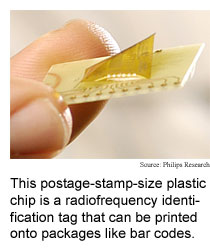
February
6, 2006
RFID
steps toward ubiquity
Radiofrequency identification (RFID) chips are increasingly used
to track shipping containers from factory to warehouse to store. The promise
-- and peril -- of RFID chips is to make every product electronically
trackable. This could happen if RFID chips were to become smaller and
cheaper.
 Two research teams have built prototypes toward this end. Researchers
from Philips Research in the Netherlands have demonstrated a postage-stamp-size,
paper-thin plastic RFID chip that can be printed onto an object. The inexpensive
chip, which operates at the standard 13.56 megahertz frequency, could
replace bar codes on packaging.
Two research teams have built prototypes toward this end. Researchers
from Philips Research in the Netherlands have demonstrated a postage-stamp-size,
paper-thin plastic RFID chip that can be printed onto an object. The inexpensive
chip, which operates at the standard 13.56 megahertz frequency, could
replace bar codes on packaging.
Researchers from Hitachi and Renesas Technology in Japan have
demonstrated an RFID chip that measures 150 microns, several times smaller
than the period at the end of this sentence. The chip is also 7.5 microns
thick, which is about ten times thinner than human hair. The chip could
be embedded in objects during the manufacturing process.
(A 13.56 MHz RFID System Based on Organic Transponders, An SOI-Based
7.5µm-Thick 0.15x0.15mm2 RFID Chip, IEEE International Solid-State
Circuits Conference (ISSCC
2006), San Francisco, February 5-9, 2006 )
Sturdy plastic nanotubes
In recent years, scientists have stretched and sliced cell-like
liposomes to make networks of tiny containers connected by tiny tubes.
To date the structures have been made of egg-white-like substances that
are relatively fragile. (See Artificial
cells make mini lab, TRN, February 21, 2001)
Researchers from the National Institute of Standards and Technology
have found
a way to make much sturdier nanotubes from polymer materials that start
out as liquids and are chemically converted into solid plastics. The tubes
were as narrow as 100 nanometers and as long as 1 centimeter.
The NIST researchers used liposomes to connect the plastic nanotubes
into networks that included Y-shaped junctions. The tiny tubular networks
could be used for performing chemistry experiments on tiny amounts of
substances and studying individual biological molecules.
(Stable and Robust Polymer Nanotubes Stretched from Polymersomes,
Proceedings of the National Academy Of Sciences, January 31, 2006)
Bits and pieces
Study Urges Nano Safety Rules
Scientists conducting a review
of nanotechnology-related scientific literature say that there is an urgent
need to establish standards and protocols for determining the safety of
nano materials. Consumers are increasingly exposed to nano materials in
a growing range of products, including cosmetics; researchers are exploring
ways of using nanoscale devices in the body for medical diagnosis and
treatment.
(Toxic Potential of Materials at the Nanolevel, Science,
February 3, 2006)
Pressure brings focus
A lens
made from a small drop of water can be focused simply by changing the
pressure on it. The technique could be used to make higher-quality, lower-cost
lenses for portable digital cameras, including cell phone cameras.
(Fluidic Lenses with Variable Focal Length, Applied Physics
Letters, January 23, 2006)
Freezing bones
The way sea water freezes has inspired a method
of making strong, lightweight composite materials. The technique could
be used to make artificial bone.
(Freezing As a Path to Build Complex Composites, Science,
January 27, 2006)
Biosensor taps transistor
Scientists have attached tiny cantilevers
to transistors to make biosensors that promise to be easy to manufacture.
The chips could be used for sensing specific pathogens or DNA molecules.
(MOSFET-Embedded Microcantilevers for Measuring Deflection in
Biomolecular Sensors, Science, published online February 2, 2006)
RSS Feeds: News Blog Books New: TRN's Internet Services TRN's Jobs Center News: Research News Roundup Research Watch blog Features: View from the High Ground Q&A How It Works Buy an ad link |
|
| Advertisements: |
|
Ad links: Clear History
Buy an ad link
|
TRN
Newswire and Headline Feeds for Web sites
|